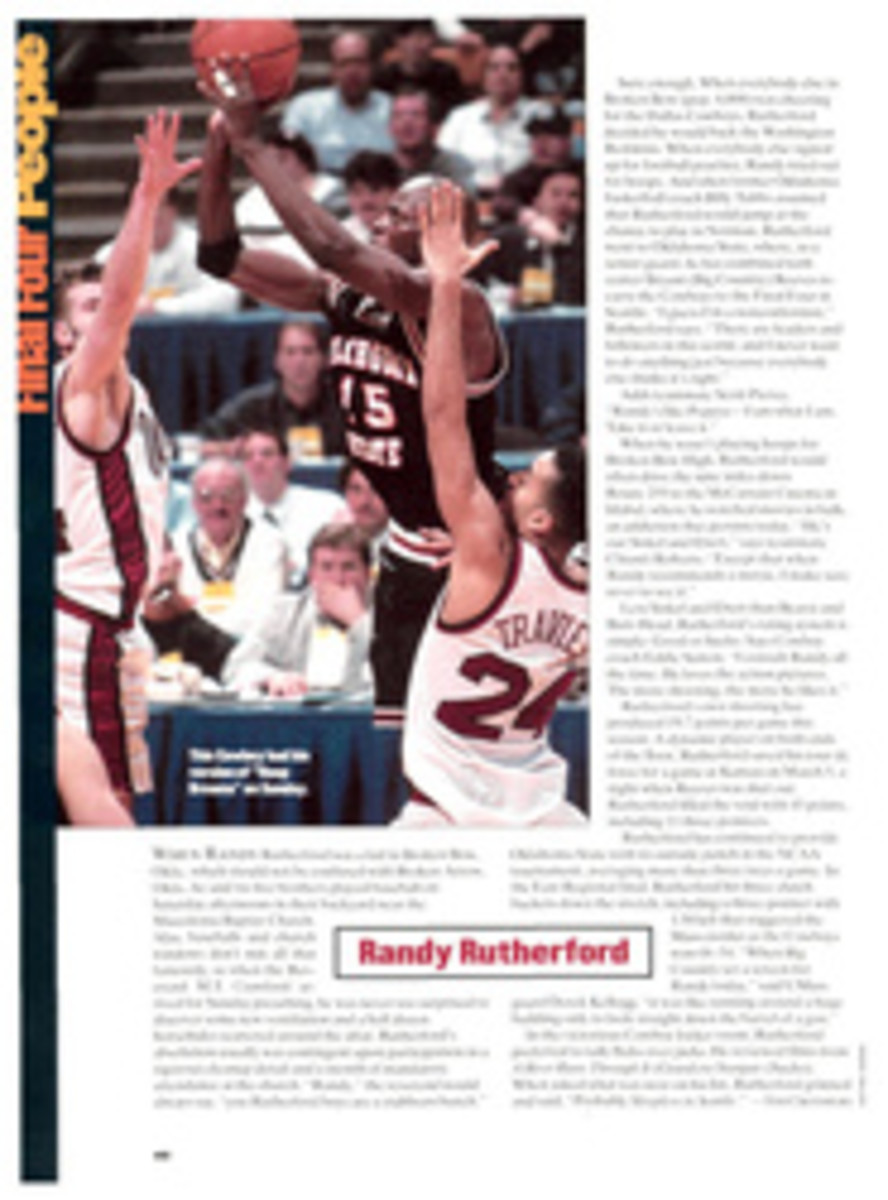
OFF THE WALL A DARING TROUPE IN CALIFORNIA MIXES DANCE, GYMNASTICS AND ROCK CLIMBING
In an alcove at the base of El Capitan's Wall of Early Morning
Light, approximately 500 feet above California's Yosemite Valley,
two figures in white, wearing harnesses clipped to safety ropes,
were crouched against a rock slab. As a warm midday breeze rustled
the trees below, the figures began to move in unison. They
contracted and released their bodies, arching against the granite
wall, their shadows dancing with them. One dancer and then the
other pushed away from the rock, leaping, lunging, twirling and
flipping over and around each other, gaining 15 feet of air and
ample hang time with each maneuver.
Meanwhile, to one side of the alcove, four more dancers harnessed
to ropes anchored at a point 150 feet farther up the wall took
turns leaping into space. They performed arabesques and flips and
aerials, spinning head over heels through the air like pinwheels
in the wind.
These high-flying routines were the work of Project Bandaloop, a
group of dancers and rock climbers who combine climbing techniques
with movements from dance and gymnastics. This performance, done
last June, was commissioned by PBS as part of The Web of Life, a
two-hour special celebrating biodiversity that will air this
month. Bandaloop, whose name is drawn from Tom Robbins's novel
Jitterbug Perfume, is based in Oakland and is the brainchild of
Amelia Rudolph, 31, the company's director. ``I want to explore
the boundaries of what is possible for the human body to do in
space,'' Rudolph says. ``My whole motivation is to put myself in a
situation in which I don't know what's going to happen.''
Dancing and rock climbing are a natural combination, Rudolph says,
because they both require strength, flexibility, coordination,
agility and concentration. In vertical dance, however, performers
must also contend with gravity in new ways. ``It does not work the
same as when you're on a horizontal plane,'' says Kimm E. Ward,
34, a Bandaloop dancer. ``In some ways it's extremely liberating,
but there are also some uncomfortable moments as you're hanging
upside down from a rope.''
Aside from the choreographic challenges, Bandaloop is primarily
concerned with technical and safety issues. Preparing for an
outdoor performance requires several days. It often takes an
experienced climber several hours just to make the ascent to the
performance area; then special care must be given to setting up
rigging mechanisms, making sure the wedges and camming devices
(spring-loaded anchors) can withstand the stress the dancers put
on them. At the other end of the ropes, the knots on the
performers' harnesses are double- and triple-checked. Bandaloop's
Peter Mayfield, 32, a onetime alternate on the U.S. climbing team
(1989) and the founder of CityRock, an indoor climbing center in
Emeryville, Calif., often either sets the dancers' anchors and
ties the knots or checks those tied by others.
Dancing on rock faces is still relatively new to the troupe's
members, including Rudolph. But in her case, at least, the seeds
were planted early in life. Rudolph was born to political
scientists with a specialty in the political economy of India, and
as a child she lived for six years in India, where she studied
classical Indian dance and music. After returning to the U.S. she
trained in modern dance, ballet and gymnastics. Rudolph graduated
from Swarthmore College in Pennsylvania and earned her master's
degree in comparative Asian religions from the Graduate
Theological Union in Berkeley, Calif.
In 1989 she took up climbing at the urging of a friend, George
McKinley, who took her to Yosemite's Tuolumne Meadows. Later,
while bouldering (climbing near the ground without ropes) at
Berkeley's Indian Rock, she was struck by the similarities between
rock climbing and dance. ``I was going sideways, traversing the
rock, and instead of paying attention to trying to stay on, I
started paying attention to where my center was and to the
fluidity of my motion,'' she recalls. ``That made it a lot easier.
The quality of the movement had almost as much to do with my
ability to stay on as did the strength of my hands and my
determination.''
Drawing on the parallels among rock climbing, dance, gymnastics,
tai chi and contact improv (an improvisational form of dance and
aikido developed in the 1970s), Rudolph brought together a few
dancers she had worked with in school and began rehearsing at
CityRock for Bandaloop's first vertical dance show. One morning
while the group was dancing on the wall, Rudolph recalls, ``Hans
Florine, who at the time was the world speed-climbing champion,
walked into our rehearsal and said, `Can I try?' ''
A few days later Florine's friend Steve Schneider, also a
nationally ranked climber, followed suit. ``I had seen vertical
dance in Europe, and it looked fun,'' says Schneider, 34. He
placed fourth in a national difficulty- climbing competition at
Snowbird, Utah, in 1990 and was fifth in 1991, and he sets routes
for national competitions. Yet he was surprised at the pressure he
felt performing with Bandaloop. ``In a climbing competition, if I
blow it I can always try again or enter another competition,'' he
says. ``But in vertical dance you have to do things within a
certain time period. Other people are depending on you. I didn't
realize what I was getting into.''
Bandaloop's first performance, at CityRock in 1991, was sold out,
as were subsequent shows in the Bay Area. The troupe now performs
several times a year, outdoors and indoors.
Despite Bandaloop's early popularity among audiences, some
climbers were suspicious of the idea of vertical dance. Last
summer Mayfield ran into climbers he had known for years, and one
called out, ``Hey, Mayfield, where's your tutu?''
``Some people in the climbing community are open-minded, others
are skeptical,'' Mayfield says, shrugging off the incident as
good-natured teasing. ``Climbers I know have come to see us
perform, and they thought it was cool.''
As for the performers themselves, many are dancers who have become
avid climbers, and some are climbers who have become dancers.
Heather Baer, a dancer who says she had ``never touched a rock
before joining Bandaloop,'' now climbs regularly, sometimes with
Schneider, her fiance, whom she met through the troupe. Mayfield,
by contrast, has taken up dance and performs with a (horizontal)
dance company in the Bay Area. In addition to performing and
teaching dance, Rudolph is the director of corporate training at
CityRock. She also competes as a climber, placing 11th in a
sport-climbing competition at CityRock in 1992 and second in speed
at last year's event.
Bandaloop plans to perform at San Francisco's Theater Artaud in
July, and Rudolph hopes to perform in India, possibly in the
Himalayas. Despite these lofty ambitions, the reality is that
finding funds to support vertical dance is a continuous challenge.
Rudolph spends a lot of time writing grant proposals, and she is a
tireless self-promoter. But thanks to her efforts, Bandaloop
scored a five-minute appearance on ESPN last November. Still, the
troupe's performers are quite a long way from being able to quit
their day jobs.
``It's the nature of the beast,'' Rudolph says. ``For a dance
company we've been lucky to get as much attention as we have,
considering how young we are. My goal is to get better at what we
do, to do it more often, and to do it all over the world. But just
doing it is good.''
Stacey Colino lives in San Francisco and writes occasionally for
Sports Illustrated.
TWO COLOR PHOTOS:JOHN MIRELES (2) Bandaloop dancer Rudolph (below, bottom) has become an avid climber.[Project Bandaloop dancers performing on side of mountain; Amelia Rudolph with other Project Bandaloop dancers performing on side of mountain]
COLOR PHOTO:SHARTEL MCVOYBandaloop troupers, trained on the horizontal, say gravity is different when the movement is vertical. [Project Bandaloop dancers performing on side of mountain]

